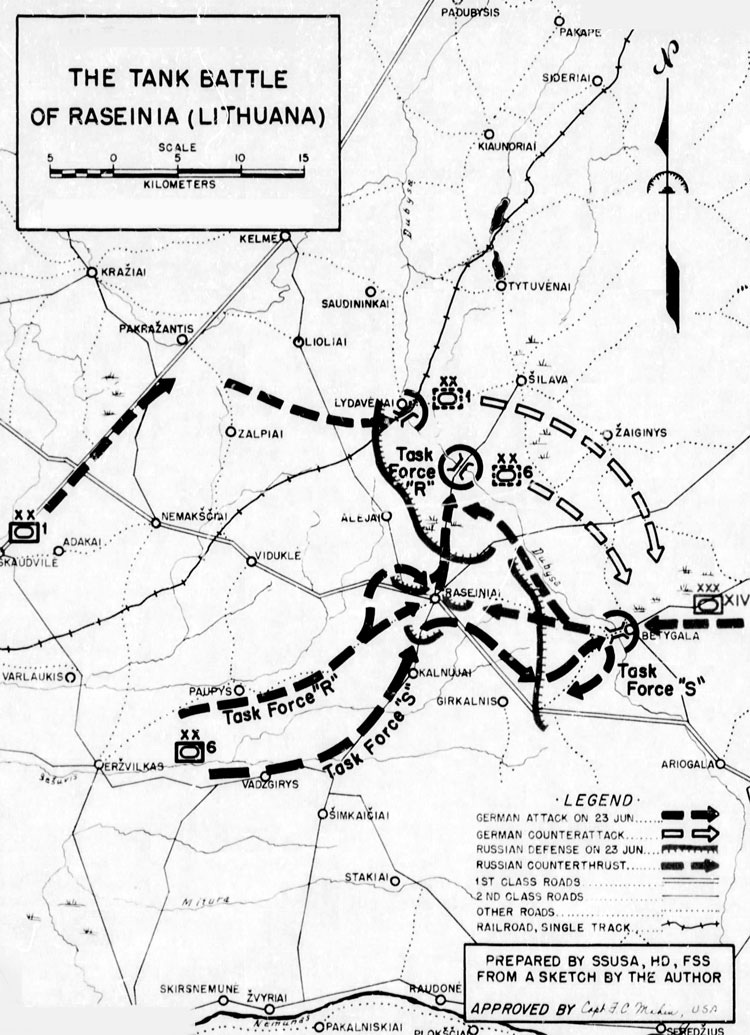Wehrmacht surprised by monster tank
23 June 1941: Advance held up by the seemingly invincible Soviet KV1
The Germans had assessed the fighting ability of the Russian army as very poor. They had not been impressed with the quality of Soviet equipment they saw when they carved up Poland, nor had the Soviets performed well during the Winter War with Finland. Stalin had systematically shot most of his best military leaders during the pre war purges.
Even as the Wehrmacht swept into Russia there were indications that this was not the complete picture. Russian resistance was fierce and determined even if it was poorly co-ordinated. And Soviet equipment was far from being wholly second rate.
On the 23rd June the 6th Panzer Division met the 2nd Soviet Armoured Division at the Dubissa river. The German commander General Reinhardt recalled their surprise:
One hundred of our tanks, about a third of them Panzer IV, occupied their positions against a counter-strike. Part of our forces met the enemy frontally, but most of them were on their flanks. They hit the steel monsters from the three sides, but the attempts to destroy them were unsuccessful. By the contrary, it was our tanks which were knocked out. After a long struggle with the Soviet giants, the German armoured units began to withdraw trying to avoid the annihilation.
…One of the KVs got close to a panzer who was stuck in a muddy brook. Without hesitation, the black monster just roll over it, crushing it completely.
Then a German 105 mm howitzer arrived. Its commander, seeing the mass of enemy tanks, ordered continuous firing, but without causing any damage. One of the KVs got close, to within 100m of the howitzer, which fired again, and its shell hit the tank full on. The tanks stopped as if hit by lightning. “We made it!” thought the gunners. “Yes, we made it!!!”, shouted the commander of the position.
But the expresson in their faces suddenly changed when one of them shouted: “It’s moving again!!”. There was no doubt – the shiny caterpillar moved up to the howitzer and crushed it like a toy, then kept on moving as if nothing had happened.
This quotation is from the Russian site War is Over .
After the war US Intelligence interviewed German officers about Russian military capabilities. They pieced together the following account of a now famous incident involving just one KV-1 tank at The Tank Battle at Raseiniai :
One of those heavy tanks even managed to reach the only supply route of the task force (Kampfgruppe) located in the northern bridgehead, and blocked it for several days. The first unsuspecting trucks to arrive with supplies were immediately shot afire by the tank. There were practically no means of eliminating the monster.
It was impossible to bypass the tank because of the swampy surrounding terrain. Neither supplies nor ammunition were brought it up. The severely wounded could not be removed to the hospital for the necessary operations, and so they died. The attempt to put the tank out of action with the 50-mm. antitank gun battery, which had just been introduced at that time, at a range of five hundred meters ended with heavy losses to crews and equipment of the battery.
The tank, however, remained undamaged in spite of the fact that, as was later determined, we scored fourteen direct hits. They merely produced blue spots on its armor. When a camouflaged 88 was brought up, the tank calmly permitted it to be put into position at a distance of seven hundred meters, and then smashed it and its crew before it was even ready to fire.
The attempt of engineers to blow it up at night likewise proved abortive. To be sure, the engineers managed to get to the tank after midnight, and laid the prescribed demolition charge under the caterpillar tracks. The charge went off according to plan, but was insufficient for the oversized tracks. Pieces were broken off the tracks, but the tank remained n»bile and continued to molest the rear of the front and to block all supplies. At first it received supplies at night from scattered enemy groups and civilians, but we later prevented this procedure by blocking off the surrounding area. However, even this isolation did not induce it to give up its favorable position.
It finally became the victim of a German ruse. Fifty tanks were ordered to feign an attack from three sides and to fire on it so as to draw all of its attention in those directions. Under the protection of this feint it was possible to set up and camouflage another 86-ram. Flak to the rear of the tank, so that this time it actually was able to fire. Of the twelve direct hits scored by this medium gun, three pierced the tank and destroyed it.
See Peculiarities Of Russian Warfare published by the U.S. Department of the Army Historical Division.





